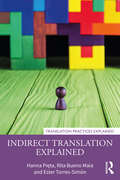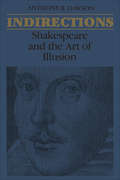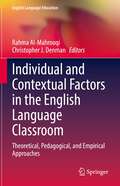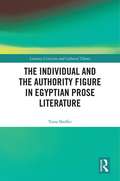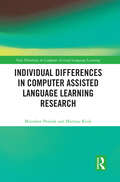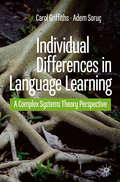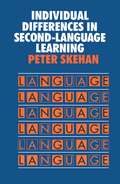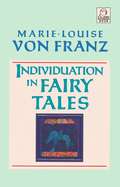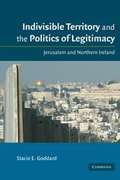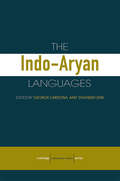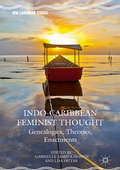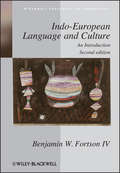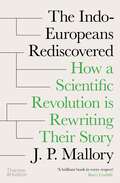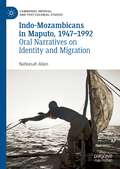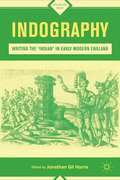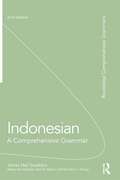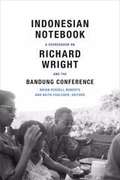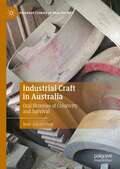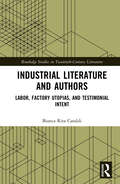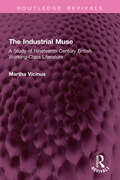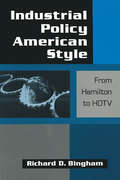- Table View
- List View
Indirect Translation Explained (Translation Practices Explained)
by Hanna Pięta Rita Bueno Maia Ester Torres-SimónIndirect Translation Explained is the first comprehensive, user-friendly book on the practice of translating indirectly in today’s world. Unlike previous scholarly approaches, which have traditionally focused on translating from the original, this textbook offers practical advice on how to efficiently translate from an already translated text and for the specific purpose of further translation. Written by key specialists in this area of research and drawing on many years of translation teaching and practice, this process-focused textbook covers a range of languages, geographical settings and types of translation, including audiovisual, literary, news, and scientific-technical translation, as well as localization and interpreting. Since this topic addresses the concerns and practices of both more peripheral and more dominant languages, this textbook is usable by all, regardless of the language combinations they work with. Featuring theoretical considerations, tasks for hands-on practice, suggestions for further discussion and diverse, real-world examples, this is the essential textbook for all students and autodidacts learning how to translate via a third language. Additional resources are available on the Routledge Translation Studies Portal: http://routledgetranslationstudiesportal.com
Indirections: Shakespeare and the Art of illusion
by Anthony DawsonThe precise relation between the spectator and the work of art was a matter of great interest to late Renaissance and baroque artists, playwrights as well as painters. In Shakespeare's plays the relation between audience and stage life is crucial. The plays constantly remind the audience of the complex fictiveness of their experience yet they also project a reality specifically through illusion. Indirections is a study of twelve plays in which Shakespeare sets up situations and relationships between the characters analogous to the relationship established between audience and play. This book examines the varied uses of illusion, deceit, disguise, and manipulation in the plays, both comedies and tragedies, and traces Shakespeare's use of illusion through his career — from the buoyant optimism of the great comedies and the ambiguity of the middle years to the new richness and power in the romances. Dawson suggests that the way characters respond to illusory situations sets up a model for the way audiences are meant to respond to the play themselves. Such action at least initially establishes a basis for the movement of characters from self-delusion to self-knowledge. This process of self-realization enables the characters to distinguish truth from appearance, love from infatuation; and significantly, it is a direct result of involvement with illusion and role-playing. It is as if the characters must arrive, within the movement of the plot, at an understanding of, and response to, the nature of drama itself parallel to the audience's experience of the play as a whole. This subtle interplay between audience and characters, where each in a sense represents the other, depends for its life on the physical and psychic distances created by the theatre.
The Indistinct Human in Renaissance Literature
by Jean E. Feerick Vin NardizziArgues for the necessity of a re-articulation of the differences that separated man from other forms of life. The essays in this collection argue for recognition of the persistently indistinct nature of humans, who cannot be finally divided ontologically or epistemologically from other forms of matter.
Individual and Community: Variations on a Theme in American Fiction
by David K. Kirby Kenneth H. BaldwinThe contributors to Individual and Community attempt to illuminate aspects of the individual-community relationship. Though different in focus and approach, the essays themselves express a "community" of concern, a concern which includes not just the situations of characters in fictional worlds, but one which touches the relationship of both novelists and reader to a world of words.The essays are intended to point to the continuity of an important theme in American fiction and to offer insight into the variety of philosophical and literary strategies utilized in significant works of significant authors in dealing with the question of the individual and the community.
Individual and Contextual Factors in the English Language Classroom: Theoretical, Pedagogical, and Empirical Approaches (English Language Education #24)
by Rahma Al-Mahrooqi Christopher J. DenmanThis edited volume examines a number of topics related to the roles of individual and contextual factors in English as second or foreign language (ESL/EFL) settings by presenting chapters across the three sections of theoretical and pedagogical approaches, teacher and learner research, and research into the roles of technology. The book has a focus on practical actions and recommendations related to individual and contextual factors in ESL/EFL, with a specific concern with issues of cognition, metacognition, emotion, and identity, and offers perspectives from a diverse range of international education settings. For teachers of ESL/EFL, the effective recognition and integration of individual and contextual factors into the classroom may represent a significant challenge. This is often the case in those settings where native English speaking teachers work in foreign language contexts where they may have limited understanding of local cultures and languages, or where language instructors have class groups that are culturally and linguistically diverse. In these, and similar, contexts, the types and extent of individual and contextual factors impacting on language learning may challenge both learner and instructor expectations of what an effective and supportive classroom is. While such a situation offers numerous opportunities for learners and teachers to expand their knowledge of themselves and each other, it also presents the possibility for ineffective teaching and learning to occur. It is within this framework that the book presents the latest theoretical, pedagogical, and research perspectives from around the world, thereby providing a resource for all stakeholders with an interest in the roles individual and contextual factors play in the English learning process.
The Individual and the Authority Figure in Egyptian Prose Literature (Literary Criticism and Cultural Theory)
by Yona ShefferThe Individual and the Authority Figure in Egyptian Prose Literature explores and analyses political conflicts between individuals and authority figures, as those conflicts are depicted in thirteen Egyptian novels written from 1957 to the last years of Mubarak's presidency. The book discusses the various reasons that lead an individual or a group of people from all strata of society (common people, intellectuals, and public figures) to confront policemen, senior security officials, and even the heads of the state. It further examines how the conflicts develop and what their outcomes are in the short term as well as in the long term, for both the individuals and the authority figures. In this context, the volume also examines the possibility of standing against an oppressive regime and even overcoming it. This text argues that while the authority figure initially subdues individuals who confront them, their victory is short term. In the long term, their cruelties bring about sown deaths, either by the individuals themselves or by their relatives. Furthermore, large assemblies of people can confront the regime with success. These discoveries, along with other findings presented in the book, remain relevant to the reality in the Middle East and the events leading to the Arab Spring.
Individual differences in Computer Assisted Language Learning Research (New Directions in Computer Assisted Language Learning)
by Miroslaw Pawlak Mariusz KrukThis book syntheses cutting-edge research on the role of individual differences (IDs) in the field of SLA and in computer assisted language learning. It also outlines the theoretical and methodological issues at the heart of this research, presents empirical findings and charts future directions of this research. Pawlak and Kruk provide an overview of the latest theoretical developments in research on IDs in SLA as well as methodological considerations that are crucial when researching individual variation, with special emphasis on data-collection procedures that are most prominent in CALL. The book goes on to summarize and explore a body of empirical evidence concerning the role of individual difference factors in CALL, singling out existing gaps, methodological problems, and areas in need of further investigation. Finally, the authors provide a guide on how empirical investigations of individual difference factors in CALL can be improved by incorporating latest developments from the broader field of SLA. This book will be of great interest to postgraduates and scholars in the domain of applied linguistics and second language education who are interested in CALL, as well as those studying and undertaking research in second language learning and teaching.
Individual Differences in Language Learning: A Complex Systems Theory Perspective
by Carol Griffiths Adem SoruçThis textbook takes a Complex Systems Theory approach to examine individual differences between learners and the potential impact of these variables on the process of acquiring a second language. The authors argue that individual variables cannot provide the complete picture, and that they must instead be understood as part of an interconnected and dynamic system of different factors in order to be useful in a language learning context. Written in an accessible style and suitable for final-year undergraduate and Masters-level students, the book includes clear definitions of key terms, discussion questions for classroom use, practical exercises and activities, and examples of real empirical studies that students and teachers can replicate in their own contexts. This textbook will be of interest to students taking TESOL and SLA courses and modules, as well as those on broader Applied Linguistics programmes.
Individual Differences in Second Language Learning (Second-language Acquisition Ser.)
by Peter SkehanUnderstanding the way in which learners differ from one another is of fundamental concern to those involved in second-language acquisition, either as researchers or teachers. This account is the first to review at book length the important research into differences, considering matters such as aptitude, motivation, learner strategies, personality and interaction between learner characteristics and types of instruction.
Individuation in Fairy Tales: Revised Edition
by Marie-Louise von FranzWith a text revised and corrected by the author, this definitive edition of Individuation in Fairy Tales is rich with insights from religion, literature, and myth. Dr. von Franz focuses on the symbolism of the bird motif in six fairy tales of Europe and Asia: "The White Parrot" (Spain), "The Bath Bagerd" (Persia), "Princess Hassan Pasha" (Turkestan), "The Bid Flower Triller" (Iran), "The Nightingale Giser" (Balkans), and "The Bird Wehmus" (Austria). She explores the themes of psychological and spiritual transformation in the varied images of birds, such as the phoenix, the parrot, and the griffin. Special attention is given to the connection between fairy tales and alchemy and to the guidance that fairy tales give to therapeutic work.
Indivisible Territory and the Politics of Legitimacy
by Stacie E. GoddardIn Jerusalem and Northern Ireland, territorial disputes have often seemed indivisible, unable to be solved through negotiation, and prone to violence and war.
The Indo-Aryan Languages (Routledge Language Family Ser.)
by Danesh Jain George CardonaThe Indo-Aryan languages are spoken by at least 700 million people throughout India, Pakistan, Bangladesh, Nepal, Sri Lanka and the Maldive Islands. They have a claim to great antiquity, with the earliest Vedic Sanskrit texts dating to the end of the second millennium B.C. With texts in Old Indo-Aryan, Middle Indo-Aryan and Modern Indo-Aryan, this language family supplies a historical documentation of language change over a longer period than any other subgroup of Indo-European. This volume is divided into two main sections dealing with general matters and individual languages. Each chapter on the individual language covers the phonology and grammar (morphology and syntax) of the language and its writing system, and gives the historical background and information concerning the geography of the language and the number of its speakers.
Indo-Caribbean Feminist Thought: Genealogies, Theories, Enactments (New Caribbean Studies)
by Gabrielle Jamela Hosein Lisa OutarBringing together three generations of scholars, thinkers and activists, this book is the first to trace a genealogy of the specific contributions Indo-Caribbean women have made to Caribbean feminist epistemology and knowledge production. Challenging the centrality of India in considerations of the forms that Indo-Caribbean feminist thought and praxis have taken, the authors turn instead to the terrain of gender negotiations among Caribbean men and women within and across racial, class, religious, and political affiliations. Addressing the specific conditions which emerged within the region and highlighting the cross-racial solidarities and the challenges to narratives of purity that have been constitutive of Indo-Caribbean feminist thought, this collection connects to the broader indentureship diaspora and what can be considered post-indentureship feminist thought. Through examinations of literature, activism, art, biography, scholarship and public sphere practices, the collection highlights the complexity and richness of Indo-Caribbean engagements with feminism and social justice.
The Indo-European Controversy
by Pereltsvaig, Asya and Lewis, Martin W. Asya Pereltsvaig Martin W. LewisOver the past decade, a group of prolific and innovative evolutionary biologists has sought to reinvent historical linguistics through the use of phylogenetic and phylogeographical analysis, treating cognates like genes and conceptualizing the spread of languages in terms of the diffusion of viruses. Using these techniques, researchers claim to have located the origin of the Indo-European language family in Neolithic Anatolia, challenging the near-consensus view that it emerged in the grasslands north of the Black Sea thousands of years later. But despite its widespread celebration in the global media, this new approach fails to withstand scrutiny. As languages do not evolve like biological species and do not spread like viruses, the model produces incoherent results, contradicted by the empirical record at every turn. This book asserts that the origin and spread of languages must be examined primarily through the time-tested techniques of linguistic analysis, rather than those of evolutionary biology.
Indo-European Language and Culture: An Introduction (Blackwell Textbooks in Linguistics #30)
by Benjamin W. Fortson IVThis revised and expanded edition provides a comprehensive overview of comparative Indo-European linguistics and the branches of the Indo-European language family, covering both linguistic and cultural material. Now offering even greater coverage than the first edition, it is the definitive introduction to the field. Updated, corrected, and expanded edition, containing new illustrations of selected texts and inscriptions, and text samples with translations and etymological commentary Extensively covers individual histories of both ancient and modern languages of the Indo-European family Provides an overview of Proto-Indo-European culture, society, and language Designed for use in courses, with exercises and suggestions for further reading included in each chapter Includes maps, a glossary, a bibliography, and comprehensive word and subject indexes
The Indo-European Languages
by Mate Kapovi 263 Anna Giacalone Ramat Paolo RamatThe Indo-European Languages presents a comprehensive survey of the individual languages and language subgroups within this language family. With over four hundred languages and dialects and almost three billion native speakers, the Indo-European language family is the largest of the recognized language groups and includes most of the major current languages of Europe, the Iranian plateau and the Indian subcontinent. Written by an international team of experts, this comprehensive, single-volume tome presents in-depth discussions of the historical development and specialized linguistic features of the Indo-European languages. This unique resource remains the ideal reference for advanced undergraduate and postgraduate students of Indo-European linguistics and languages, but also for more experienced researchers looking for an up-to-date survey of separate Indo-European branches. It will be of interest to researchers and anyone with an interest in historical linguistics, linguistic anthropology and language development.
The Indo-Europeans Rediscovered: How a Scientific Revolution is Rewriting Their Story
by J. P. MalloryA lifetime's study brings revealing expertise to an oft-misunderstood topic in human history—the origin and language of the Indo-Europeans. Today the number of native speakers of Indo-European languages across the world is approximated to be over 2.6 billion—about 45 percent of the Earth’s population. Yet the idea that an ancient, prehistoric population in one time and place gave rise to a wide variety of peoples and languages is one with a long and troubled past. In this expansive investigation, based on more than forty years of research, archaeologist J. P. Mallory navigates the complex history of our search for the Indo-European homeland, offering fresh insight into the debates surrounding origin, as well as the latest genetic research. In this compelling account, Mallory explores ancient migrations, linguistics, and archaeology, applying cutting-edge genetic research to untangle the key arguments with wit and verve. He addresses how the controversial idea of a single, shared homeland has been viewed by scientists, archaeologists, and linguists across the past century and reconsiders how, in the case of the Nazis and more recent nationalist movements, they have been manipulated for political advantage. The author goes on to analyze the linguistic trail linking current populations to the Indo-Europeans, looking at Sanskrit, Greek, Latin, and more, as he traces linguistic origins across multiple peoples and cultures, bringing the most up-to-date phylogenetic research to bear on this story. Ultimately this important volume offers the most conclusive and nuanced understanding of an oft-misrepresented and misunderstood topic.
Indo-Mozambicans in Maputo, 1947-1992: Oral Narratives on Identity and Migration (Cambridge Imperial and Post-Colonial Studies)
by Nafeesah AllenThis book explores the experiences of ‘Indo-Mozambicans,’ citizens and residents of Mozambique who can trace their origins to the Indian subcontinent, a region affected by competing colonialisms during the twentieth century. Drawing from ethnographic interviews, the author illustrates why migration developed as both an identity marker and a survival tool for Indo-Mozambicans living in Maputo, in response to the series of independence movements and prolonged period of geo-political uncertainty that extended from 1947 to 1992. A unique examination of post-colonialism, the book argues that four pivotal moments in history forced migratory patterns and ethnic identity formations to emerge among Indo-Mozambicans, namely, the end of the British empire in India and the subsequent partition of India and Pakistan in 1947; the end of the Portuguese empire in India, with the annexation of Goa, Daman and Diu in 1961; the independence of Mozambique from Portugal in 1975; and the civil war of Mozambique from 1977 to 1992. Framing these historical markers as trigger points for shifts in migration and identity formation, this book demonstrates the layered experiences of people subject to Portuguese colonialism and highlights the important perspective of those ‘left behind’ in migration studies.
Indography
by Jonathan Gil HarrisIn the fifteenth and sixteenth centuries, Europeans invented 'Indians' and populated the world with them. The global history of the term 'Indian' remains largely unwritten and this volume, taking its cue from Shakespeare, asks us to consider the proximities and distances between various early modern discourses of the Indian. Through new analysis of English travel writing, medical treatises, literature, and drama, contributors seek not just to recover unexpected counter-histories but to put pressure on the ways in which we understand race, foreign bodies, and identity in a globalizing age that has still not shed deeply ingrained imperialist habits of marking difference.
Indonesian: A Comprehensive Grammar (Routledge Comprehensive Grammars)
by James Neil Sneddon K Alexander Adelaar Dwi N. Djenar Michael EwingThis grammar is a complete reference guide to the language of Indonesia as used by native speakers. The book is organised to promote a thorough understanding of Indonesian grammar. It presents the complexities of Indonesian in a concise and readable form. An extensive index, cross-referencing and a generous use of headings will provide readers with immediate access to the information they require. Key features: to aid clarity, all word groups and structures discussed are illustrated by natural examples of frequently used words and expressions each section can be read independently, enabling the reader to focus on a specific aspect of the language, if required all major structures of Indonesian, from words to complex sentences are described in detail common grammatical terms used are all clearly defined in an extensive glossary. By providing a comprehensive description of Indonesian in a clear and non-technical manner, this grammar makes an ideal reference source for all users of the language, whether in colleges, universities or adult education classes of all types. James Neil Sneddon was Associate Professor in the Faculty of Asian and International Studies at Griffith University, with long experience teaching Indonesian language and linguistics. He is also author of Understanding Indonesian Grammar. Alexander Adelaar is Principal Fellow in the Asia Institute at the University of Melbourne. He is author of a number of books on Austronesian linguistics. Dwi Noverini Djenar lectures in the Department of Indonesian Studies at the University of Sydney. She is author of Semantic, Pragmatic and Discourse Perspectives of Preposition Use: A study of Indonesian locatives. Michael C Ewing is a senior lecturer in Indonesian Studies at the Asia Institute at the University of Melbourne. He is author of Grammar and Inference in Conversation: Identifying clause structure in spoken Javanese.
Indonesian Notebook: A Sourcebook on Richard Wright and the Bandung Conference
by Brian Russell Roberts Keith FoulcherWhile Richard Wright's account of the 1955 Bandung Conference in The Color Curtain has been key to shaping Afro-Asian historical narratives, Indonesian accounts of Wright and his conference attendance have been largely overlooked. Indonesian Notebook contains myriad documents by Indonesian writers, intellectuals, and reporters, as well as a newly recovered lecture by Wright, previously published only in Indonesian. Brian Russell Roberts and Keith Foulcher introduce and contextualize these documents with extensive background information and analysis, showcasing the heterogeneity of postcolonial modernity and underscoring the need to consider non-English language perspectives in transnational cultural exchanges. This collection of primary sources and scholarly histories is a crucial companion volume to Wright'sThe Color Curtain.
Industrial Craft in Australia: Oral Histories of Creativity and Survival (Palgrave Studies in Oral History)
by Jesse Adams SteinThis book is the first of its kind to investigate the ongoing significance of industrial craft in deindustrialising places such as Australia. Providing an alternative to the nostalgic trope of the redundant factory ‘craftsman’, this book introduces the intriguing and little-known trade of engineering patternmaking, where objects are brought to life through the handmade ‘originals’ required for mass production.Drawing on oral histories collected by the author, this book highlights the experiences of industrial craftspeople in Australian manufacturing, as they navigate precarious employment, retraining, gendered career pathways, creative expression and technological change. The book argues that digital fabrication technologies may modify or transform industrial craft, but should not obliterate it. Industrial craft is about more than the rudimentary production of everyday objects: it is about human creativity, material knowledge and meaningful work, and it will be key to human survival in the troubled times ahead.
Industrial Literature and Authors: Labor, Factory Utopias, and Testimonial Intent (Routledge Studies in Twentieth-Century Literature)
by Bianca Rita CataldiIn recent years, the field of literary studies at the international level has become more involved in the analysis of the so-called industrial literature, a literary genre that focuses on the literary representation of factory work and workers’ alienation. This book engages in the ongoing debate by offering a narratological analysis of Italian industrial novels in particular, while taking into consideration their paratexts and interrogating the possibility of the presence of a testimonial intent in the text. The study reconstructs the connections between visions of factory utopias and Italian industrial literature, starting with an overview of said visions of utopia and how they came into being in Europe following the industrial revolution. It then proceeds by exploring the relationship between the twentieth-century Italian entrepreneur Adriano Olivetti and Italian industrial authors, and the influence that Olivetti’s visions of factory utopia had on these writers and how they perceived themselves as witnesses of factory life and workers’ alienation. In analyzing these texts, and particularly the novels by Paolo Volponi and Ottiero Ottieri, the book focuses on the previously overlooked representation of the self in industrial literature and on how this self expresses the need for testimony.
The Industrial Muse: A Study of Nineteenth Century British Working-Class Literature (Routledge Revivals)
by Martha VicinusFirst published in 1974, The Industrial Muse is a study of the literary achievements of the working class. The focus is upon the cultural environment and assumptions of self-educated writers, their literary preoccupations and careers, and the content, form and structure of their writings.This literature must first be considered from the perspective of the working people who read and wrote it, for it functioned in their lives in a number of important ways. Its character was due in large part to the conscious efforts of educated workers who wish to gain cultural recognition along with social and economic justice. It helped to shape individual and class consciousness by giving order to working men's lives and clarifying their relationship with those who held cultural and political power. This literature asserted the autonomy of the working class, but did not posit a new worldview, lest the gains of class solidarity be lost irretrievably. This is an interesting read for scholars and researchers of working-class literature, english literature and working-class history.
Industrial Policy American-style: From Hamilton to HDTV
by Richard D. BinghamThe proper role of government in the US economy has long been the subject of ideological dispute. This study of industrial policy as practised by administration after administration, explores the variations from a hands-off approach to protectionist policies and aggressive support for businesses.
